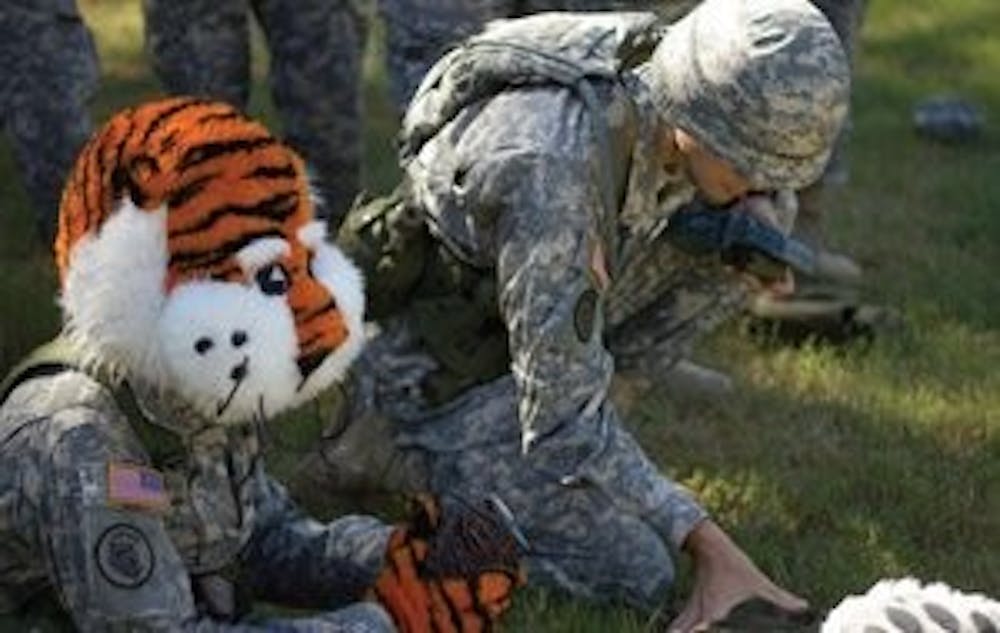G.I. Jobs magazine has recently named Auburn one of the top military-friendly schools in the nation.
"I think it's just the Southern environment," said Scott Luis, senior in political science. "Almost everyone knows a friend or family member in the military, and I've just been welcomed by everybody.
"I've had people come up and say, 'thank you for your service,' and every time I go to the Student Center somebody says it. It's just such a great environment, and it encourages people."
Katelyn Reed, senior in English, said participating in Auburn's ROTC program is an honor for all the cadets.
"Participating in Army ROTC provides students with unique experiences," Reed said. "Army cadets get to travel to different posts and train with equipment and weapons reserved for soldiers. It is a privilege to work with the same thing that our troops overseas are. The cadets understand the reality of it and always take training seriously."
Maya Nguyen, sophomore in communication, said the most important part of ROTC is the Leadership Development Assessment Course.
"It's 28 days of training after your junior year and it essentially decides your future in the Army," Nguyen said. "How you do in LDAC, plus your GPA, plus your physical training score is what decides whether you're in active duty or the reserves."
In order to prepare for the LDAC camp, Nguyen said the AROTC hosts lab sessions every Wednesday so cadets can get practical experience.
"What we do for lab depends on the seniors who train us," Nguyen said. "(The grenade assault course) is one of the funner labs. We also do land navigation a lot. They give us a direction and a distance, and we have to go find these triangular numbers in the woods. It's really important for camp, so we do it a lot."
Reed said for the grenade lab they use equipment allotted to the AROTC by Fort Benning.
"This is a special lab because we're using live grenades at some of the stations," Reed said. "We're allotted so many, so we have to use them up. We're not going to lose trees, though. They're training grenades, so they'll go off, and if you held onto it with hand, it's like a grenade version of holding a sparkler too long. It will spark, and it will hurt very badly, but they don't blow things up."
As part of the training, cadets learned to throw grenades from standing and kneeling positions, and they also raided a makeshift bunker made of wood.
"You'll see in movies there'll be a big concrete dome, and it'll have like a machine gun in it, so we learn to properly clear it by throwing a grenade with a bunker assault team," Luis said.
Luis and Reed are two of the seniors in charge of organizing these labs.
"We get jobs once we're a senior, and there's five of us who are training the freshmen and five who train the sophomores," Luis said. "We all got here because we like to teach. We're all trainers because they thought we'd be good teachers, and we enjoy dealing with the underclassmen, so I'll stay here until 6 p.m. if someone wants to stay and learn more. It just depends on the needs of the people you're training."
Nguyen said the equipment used during the labs makes the experience as true-to-life as possible, and the uniforms they wear are the same as they would wear on active duty in the military.
"We have our ammo pouch, but we don't have any ammo, so usually it holds our Starburst and Skittles for land navigation when you get bored," Nguyen said. "We also use our ranger beads for land navigation. You pull one bead every 100 meters to help you keep track of how far you've gone."
Nguyen said the Army uniform is a lot more practical than everyday clothes, so she likes being able to wear it on lab days.
"There are a lot of pockets," Nguyen said. "I love Wednesdays because my keys go here, and I don't have to dig in my backpack for them. There's even a pocket in the hat."
Luis said the cadets usually carry plastic rifles as well.
"The fake weapons we usually have out," Luis said. "We almost always do that in any sort of tactics because you'll always be carrying a weapon when you're doing stuff like this."
The activities and classes are difficult, but Reed said they also bring AROTC members closer together.
"These kids work really hard, and you have to maintain your GPA to be on active duty status with the Army these days," Reed said. "They have PT (physical training) every morning for an hour and a half, and they have classes. It takes a lot out of you because you're competing with each other, but you also have to be good friends."
Reed said AROTC members will continue to follow four major principles as they continue their training.
"It is important that the Auburn campus knows what Army ROTC is all about: hard work, academics, physical training and brotherhood," Reed said.
Do you like this story? The Plainsman doesn't accept money from tuition or student fees, and we don't charge a subscription fee. But you can donate to support The Plainsman.





